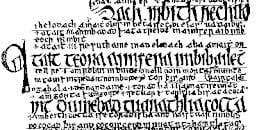
Brehon Laws
In pre-Christian Irish society, brehons or judges laid down the law. This early body of law is now recognised as probably the oldest known European example of a sophisticated legal system. The Brehon law survived relatively intact right through the Early Christian period and on to the arrival of the Normans. The waves of forced settlement that followed meant that this legal system’s days were numbered, although it did survive in part right up to the 17th century.
The Brehon laws were originally composed in poetic verse and memorised by the Brehons. As time went by, these laws were written down by Christian scholars. Today, texts like the 8th century Bretha Comaithchesa (or ‘Laws of the Neighbourhood’) prove just how advanced the Brehon legal system was for its time.
Brehon law was the law of a pastoral people, whose economics were based on a self-sufficient agricultural economy regulated by tribal and family relationships and where wealth was measured in terms of cattle ownership. There were no units of money and barter was the main form of exchange.

Crab apple – one of the ‘nobles of the wood’ (photo A. Bridge)
It should come as no surprise therefore that there were specific Brehon laws dealing with trees. Under these laws, certain trees and shrubs were protected because of their importance to the community. Penalties were imposed for any unlawful damage such as branch-cutting, barking or base-cutting.
There were four classes of tree, roughly mirroring classes in early Irish society. These were the airig fedo (‘nobles of the wood’), the aithig fedo (‘commoners of the wood’), the fodla fedo (‘lower divisions of the wood’) and the losa fedo (‘bushes of the wood’). Which group a tree belonged to depended on its economic importance, usually related to its fruit, timber or size when fully grown.
The díre or penalty for an offence was a fine in the form of livestock. The penalties were graded according to the class of tree harmed and the form of damage inflicted. The díre for felling one of the nobles of the wood was two and a half milk cows, while the penalty for cutting down one of the commoners of the wood was one milk cow, and so on.
This Old Irish Tree-List, as it has come to be known, not only provides us with a fascinating example of Brehon law in action, but also gives us some insight into the nature of ancient Irish society and the role and importance of trees in the daily lives of our ancestors.
Airig Fedo
(Nobles)
Dair/Oak
Coll/Hazel
Cuileann/Holly
Ibar/Yew
Uinnius/Ash
Ochthach/Scots pine
Aball/Crab Apple
Fodla Fedo
(Lower Divisions)
Draigen/Blackthorn
Trom/Elder
Feoras/Spindle
Findcholl/Whitebeam
Caithne/Arbutus
Crithach/Aspen
Crann Fir/Juniper
Aithig Fedo
(Commoners)
Fern/Alder
Sail/Willow
Scé/Hawthorn
Caorthann/Rowan
Beithe/Birch
Lem/Elm
Idath/Cherry
Losa Fedo
(Bushes)
Raith/Bracken
Rait/Bog Myrtle
Aiten/Furze
Drís/Bramble
Fróech/Heather
Gilcach/Broom
Spín/Wild Rose
For further information see the paper Trees in Early Ireland by Fergus Kelly,
Augustine Henry Memorial Lecture, 11th March,1999, Royal Dublin Society.
In this article an attempt is made to identify all the twenty-eight trees and shrubs which are listed in Old Irish law-text of about the eight century AD. There is also an account of trees which are mentioned in early Irish poetry and proverbs, as well as brief description of woods and woodland management in pre-Norman Ireland. The article concludes with a discussion of tree-references in early English, Scottish and Welsh sources.
